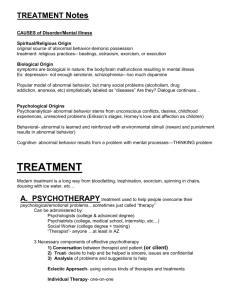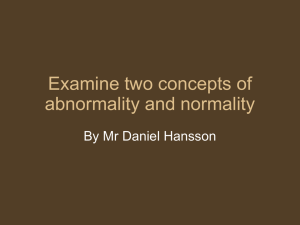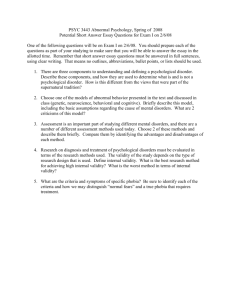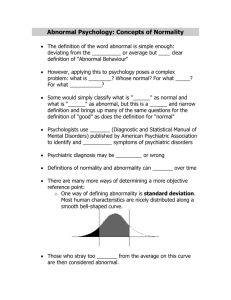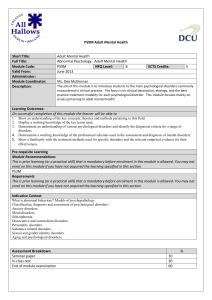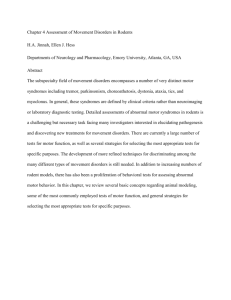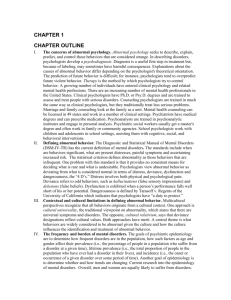para 1 - Cengage Learning
advertisement
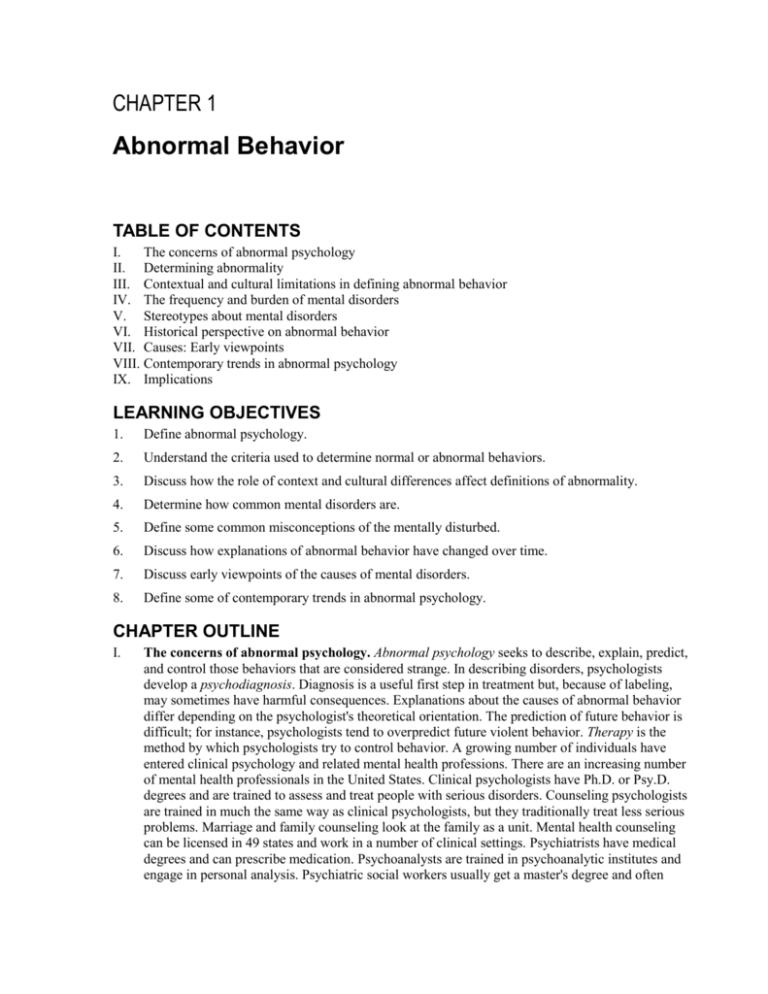
CHAPTER 1 Abnormal Behavior TABLE OF CONTENTS I. The concerns of abnormal psychology II. Determining abnormality III. Contextual and cultural limitations in defining abnormal behavior IV. The frequency and burden of mental disorders V. Stereotypes about mental disorders VI. Historical perspective on abnormal behavior VII. Causes: Early viewpoints VIII. Contemporary trends in abnormal psychology IX. Implications LEARNING OBJECTIVES 1. Define abnormal psychology. 2. Understand the criteria used to determine normal or abnormal behaviors. 3. Discuss how the role of context and cultural differences affect definitions of abnormality. 4. Determine how common mental disorders are. 5. Define some common misconceptions of the mentally disturbed. 6. Discuss how explanations of abnormal behavior have changed over time. 7. Discuss early viewpoints of the causes of mental disorders. 8. Define some of contemporary trends in abnormal psychology. CHAPTER OUTLINE I. The concerns of abnormal psychology. Abnormal psychology seeks to describe, explain, predict, and control those behaviors that are considered strange. In describing disorders, psychologists develop a psychodiagnosis. Diagnosis is a useful first step in treatment but, because of labeling, may sometimes have harmful consequences. Explanations about the causes of abnormal behavior differ depending on the psychologist's theoretical orientation. The prediction of future behavior is difficult; for instance, psychologists tend to overpredict future violent behavior. Therapy is the method by which psychologists try to control behavior. A growing number of individuals have entered clinical psychology and related mental health professions. There are an increasing number of mental health professionals in the United States. Clinical psychologists have Ph.D. or Psy.D. degrees and are trained to assess and treat people with serious disorders. Counseling psychologists are trained in much the same way as clinical psychologists, but they traditionally treat less serious problems. Marriage and family counseling look at the family as a unit. Mental health counseling can be licensed in 49 states and work in a number of clinical settings. Psychiatrists have medical degrees and can prescribe medication. Psychoanalysts are trained in psychoanalytic institutes and engage in personal analysis. Psychiatric social workers usually get a master's degree and often 2 Chapter 1: Abnormal Behavior work in family or community agencies. School psychologists work with children and adolescents in school settings, assisting them with cognitive, social, and behavioral interventions. II. Defining abnormal behavior. The Diagnostic and Statistical Manual of Mental Disorders (DSMIV-TR) has the current definition of mental disorders. The standards include when are behaviors significant, what are present distresses, painful symptoms and ascertaining increased risk. The statistical criterion defines abnormality as those behaviors that are infrequent. One problem with this standard is that it provides no consistent means for deciding what is rare and what is undesirable. Psychologists view abnormal behavior as deviating from what is considered normal in terms of distress, deviance, dysfunction and dangerousness, the “4 D’s.” Distress involves both physical and psychological pain. Deviance refers to odd behaviors, such as hallucinations (false sensory impressions) and delusions (false beliefs). Dysfunction is exhibited when a person’s performance falls well short of his or her potential. Dangerousness is defined by Tarasoff v. Regents of the University of California which indicates that psychologists have “a duty to protect.” III. Contextual and cultural limitations in defining abnormal behavior. Multicultural perspectives recognize that all behaviors originate from a cultural context. One approach is cultural universality, the traditional viewpoint on abnormality, which states that there are universal symptoms and disorders. The opposite, cultural relativism, says that deviance designations reflect cultural values. Both approaches have merit. A central theme is what behaviors are widely considered to be abnormal given the culture and how the culture influences the identification and treatment of abnormal behavior. IV. The frequency and burden of mental disorders. The goals of psychiatric epidemiology are to determine how frequent disorders are in the population, how such factors as age and gender affect their prevalence (i.e., the percentage of people in a population who suffer from a disorder at a given time), lifetime prevalence (i.e., the total proportion of people in the population who have ever had a disorder in their lives), and incidence (i.e., the onset or occurrence of a given disorder over some period of time). Another goal of epidemiology is to determine whether and how trends are changing. Current research into the epidemiology of mental disorders. Overall, men and women are equally likely to suffer from disorders; however, men are more likely to have alcohol problems and women are more likely to become depressed or anxious. Older people are vulnerable to cognitive impairments. Mental illness ranks higher than malignant disease with respect to lost years of healthy life. Fewer than one-third of people with disorders receive mental health services. V. Stereotypes about the mentally disturbed. One myth is that mentally disturbed people can be readily spotted. This is not true because there are no sharp dividing lines between normality and abnormality and because some forms of deviance can be hidden. Another myth is that mental disorder is always inherited. Genetics can play a role in some disorders, but even in those disorders where genes are thought to play a role, environmental stress is a crucial influence. Other myths are that people with mental disorders cannot be cured, that their problems stem from a lack of willpower, that mental illness is always a deficit and those who suffer disorders contribute nothing to society, and that they are more dangerous than other people. VI. Historical perspectives on abnormal behavior. How people view mental disorders is related to the beliefs of their culture ad time. During prehistoric times, people believed in demonology (demonic possession, sorcery, or the behest of an offended ancestral spirit). Treatments included trephining (chipping open the skull so the evil spirit could escape) and exorcism (prayers, noisemaking, even starvation to drive out spirits). Naturalistic explanations during the GrecoRoman era, relied heavily on observations and explanations attributing disorders to organic factors such as brain pathology. Reversion to supernatural explanations in the Middle Ages. during the Dark Ages, the Catholic Church dominated all thought and reverted to supernatural explanations for mental disorders. In the 13th century, whole populations were sometimes affected by such forms of mass madness as tarantism (a dance mania) and lycanthropy (in which people believed Chapter : Abnormal Behavior 3 themselves to be wolves). Witchcraft became a common explanation for abnormal behavior in the 15th-17th centuries, when the Catholic Church was under attack. Some mentally ill people were considered witches and received brutal punishment, but most accused witches were probably sane. The Malleus Maleficarum (Witch’s Hammer) is published. The rise of humanism (the Renaissance) took place in the 14th – 16th centuries, stressing human welfare and rejecting the supernatural aspects of witchcraft. Johann Weyer asserted that people who had been thought to be witches were actually mentally disturbed. The reform movement (18th and 19th centuries) led to the moral treatment movement; it began in France (Philippe Pinel) and England (William Tuke). In America (Benjamin Rush), mental patients were also treated more humanely. Dorothea Dix pushed for the improvement of care for individuals with mental disorders and for the building of mental hospitals. Clifford Beers exposed the cruel treatment he and other patients experienced in mental institutions. Generally, treatment for the mentally ill has improved in this century. VII. Causes: Early viewpoints. From Hippocrates’ day to our own, organic explanations of abnormality have existed. During the late 1800s, there was a strong increase in this biological viewpoint, which was supported by the discovery that general paresis had an organic cause. Emil Kraepelin observed that certain symptoms occur in clusters, called syndromes, with each syndrome having a unique cause. Kraepelin classified the mental illnesses on the basis of organic causes. The psychological viewpoint is an alternative view that suggests emotions can cause mental disorders. Anton Mesmer used trances (mesmerism) to treat people with hysteria, sometimes successfully. Although he was declared a fraud, these treatments underscored the power of suggestion for curing disorder. Mesmerism and Hypnotism was studied and used by several French physicians (Liebeault, Bernheim, and Charcot) to treat hysteria during the late 1800s, this was called the Nancy School. Breuer found that reliving past experiences through catharsis removed symptoms, too. Sigmund Freud built upon this foundation. A dichotomous approach, behaviorism, was firmly rooted in laboratory research and stressed the importance of directly observable behaviors and the conditions of stimuli that evoked, reinforced, and extinguished them. VIII. Contemporary trends in abnormal psychology. Twentieth-century views of abnormality have been influenced by the introduction of psychiatric drugs in the drug revolution of the1950s, which led to a great reduction in patients residing in mental institutions (deinstitutionalization). Psychologists have initiated legislative efforts to gain prescription privileges to treat individuals with mental disorders Medical providers (psychiatrists) are opposed to non-medical personnel having prescription privileges, and not all psychologists support psychologists’ expansion into the psychopharmacological realm, fearing that psychologists will lose their own professional identity. Managed health care, which attempts to contain costs by increasing the oversight of treatment by outside reviewers and by requiring treatment professionals to justify their therapies, may alter the types of care provided. Appreciation for research: professionals in abnormal psychology value research on both the biological and psychological bases of behavior for understanding and treating mental disorders. Diversity and multicultural psychology: Changes in the racial and ethnic diversity of the United States have helped create a new field called multicultural psychology. Racial, cultural, age, and gender differences in apparent mental disorders may be explained in terms of social conditioning (e.g., stereotyping), cultural values that are taught, and sociopolitical influences such as prejudice, which prompt healthy coping mechanisms that may be seen as symptoms. Bias in diagnosis is another explanation for differences in minority mental health. IX. Implications Increasingly, professionals value a multi-path approach, which acknowledges that biological, psychological, and social factors combine to explain most disorders. KEY TERMS REVIEW 1. The therapeutic use of verbal expression to release pent-up unconscious conflicts is called the __________________. 4 Chapter 1: Abnormal Behavior 2. The belief that mental disorders are caused by psychological or emotional factors is called the __________________. 3. The ancient. surgical technique in which part of the skull was chipped away to provide an escape for evil spirits is called __________________. 4. The industrialization of health care, whereby organizations in the private sector control the delivery of services is called __________________. 5. Begun by Philippe Pinel, this movement was a shift toward more humane treatment for mentally disturbed patients. It was called the __________________. 6. A cluster of symptoms that tend to occur together, believed to be indicative of a particular disorder, is called a(n) __________________. 7. A program of systematic intervention whose purpose is to modify a client’s behavior, emotions, or thoughts is called __________________. 8. The scientific discipline that seeks to describe, explain, predict, and control behaviors that are considered unusual is called __________________. 9. The philosophical movement that emphasizes human welfare and the worth of the individual, and that challenged supernatural explanations of deviant behavior, is called __________________. 10. The belief that mental disorders have a physical or physiological basis is called the __________________. 11. The belief that the origin and manifestation of disorders are equally applicable across all cultures is called __________________. 12. The belief that lifestyles, cultural values, and world views affect the expression and determination of deviant behavior is called __________________. 13. An attempt to describe, assess, and systematically draw inferences about an individual's psychological disorder is called a(n) __________________. 14. The contemporary approach that sees the cause of most disorders as a combination of biological, psychological, and social factors is called the __________________. 15. __________ is a clinically significant behavioral or psychological syndrome or pattern that occurs in an individual and that is associated with present distress (e.g., a painful symptom) or disability (i.e., impairment in one or more important areas of functioning) or with a significantly increased risk of suffering death, pain, disability, or an important loss of freedom 16. The ritual in which prayer, noise, and extreme measures such as starvation were used to cast evil spirits out of an afflicted person’s body is called __________________. 17. Group hysteria in which large numbers of people exhibit similar symptoms that have no apparent physical cause is called __________________. 18. The field of psychology that stresses the importance of race, ethnicity, gender, and culture in understanding abnormal behavior is called __________________. 19. A dysfunction or disease of the brain is called a __________________. 20. The percent of individuals in a population who suffer from a mental disorder at a given point in time is called the __________________. 21. The rate of occurrence of a disorder over a period of time is referred to as __________________. Chapter : Abnormal Behavior 22. The total proportion of people in the population who have ever had a disorder in their life is the __________________. 23. It appears that, __________________, or abnormal behavior, is not the result of any singular cause but an interaction of many factors. 24. ____________ is a psychological perspective that stresses the importance of learning and behavior in explanations of normal and abnormal development FACTUAL MULTIPLE-CHOICE QUESTIONS 1. 2. 3. 4. 5. 6. 7. Psychologists attempt to change or control abnormal behavior through the process of a. psychodiagnosis. b. therapy. c. research. d. clinical assessment. According to the practical criterion for defining abnormality, when a person complains of an extended period of anxiety, fatigue, and other physical or mental symptoms but is able to fulfill his or her expected social roles, this is evidence of a. dysfunction. b. discomfort. c. deviance. d. delusions. False sensory impressions are called __________________ contradictory evidence are called __________________. a. dysfunctions; delusions b. hallucinations; delusions c. sensorimotor deviation; dementia d. delusions; hallucinations Based on the National Institute of Mental Health epidemiological study of mental disorders in three major cities, a. the rate of mental disorders has steadily decreased over the past twenty years. b. approximately 1 in 50 Americans suffers from an emotional disorder. c. depression is among the least common disorders in the United, States. d. alcohol problems are more common in men than in women. Tarantism and lycanthropy are examples of __________________, which occurred during the __________________. a. mesmerism; 1200s b. mass madness; 1200s c. exorcism; 1800s d. mass madness; time of ancient Greece and Rome Clifford Beers, Dorothea Dix, and Benjamin Rush were all a. Americans who supported Freud’s psychoanalytic theory. b. researchers on hypnosis and hysteria. c. involved in improving the treatment offered in mental institutions. d. supporters of the idea that mental disorder stems from organic causes. The technique of mesmerism was a forerunner of a. hypnotism. b. drug therapy. 5 6 8. 9. Chapter 1: Abnormal Behavior c. exorcism. d. trephining. Most psychologists believe that mental disorders are caused by a. psychological factors only. b. heredity and brain deficits. c. cultural factors only. d. a combination, of biological, psychological, and societal influences, the multi-path approach. A clinical psychologists education includes a. required training in psychoanalysis. b. four years of medical school. c. getting a Ph.D. or Psy.D. degree. d. no training in assessment or prevention of abnormal behavior. 10. Among all the mental health professionals, only the __________________ can currently prescribe medication. a. psychiatrist b. clinical psychologist c. psychiatric social worker d. counseling psychologist 11. Behaviorism has been _______________ in treating maladaptive behaviors. a. somewhat dangerous b. fairly ineffective c. prohibited d. quite successful CONCEPTUAL MULTIPLE-CHOICE QUESTIONS 1. 2. 3. 4. One limitation in using the statistical criterion for defining abnormal behavior is the inability to a. distinguish rare behaviors that are desirable from those that are undesirable. b. consider how frequently a behavior occurs in the population. c. show a relationship between prediction and control of behavior. d. use objective, empirical information about deviant behavior. Dr. Chiu argues that in defining abnormal behavior, psychologists should use the ideal mental health criterion because this criterion a. is based on whether the individual's behavior is bizarre and inefficient and causes personal discomfort. b. is the most comprehensive and has the fewest drawbacks. c. considers deviations from positive goals assumed to be important for the individual. d. is based on the frequency of deviant actions. In contrast to traditional views of abnormality, cultural relativism a. rejects the idea that behaviors defined as abnormal in western culture are abnormal everywhere else. b. emphasizes the idea that abnormality is best defined in terms of deviation from some ideal of mental health. c. argues that there is no such thing as mental illness. d. supports the idea that abnormality is based primarily on biological differences. Dysfunction suggests that mental disorder be seen as a. a biologically caused phenomenon that is unaffected by society. b. having three components: rarity, deviation from ideal, and cultural norms. Chapter : Abnormal Behavior 7 c. a functional deficiency caused by biological factors that is seen as harmful by society. d. the result of poor parenting, inadequate social resources, and unavailable treatment. 5. Which of the following statements is accurate concerning heredity and mental disorder? a. Heredity plays a powerful causal influence and the occurrence of most every mental disorder and environmental factors play almost no role. b. Heredity has been found to play almost no role in even the most serious mental disorders. c. Because most mental disorders are inherited, they cannot be cured. d. Although heredity plays an important role in some disorders, the environment plays a major role in all of them. 6. Which of the following treatments for abnormal behavior is correctly paired with its period in history? a. Exorcism—Middle Ages b. Trephining—Renaissance c. Exorcism—moral treatment era d. Cathartic method—moral treatment era 7. Modern interpretations of witchcraft suggest that a. people who were seen as voluntary witches were treated with sympathy and kindness. b. witches were often not insane. c. the church actually tried to stop the hunting of witches. d. the church believed that witches were suffering from brain pathology. 8. A person who discusses mental disorders in terms of syndromes and believes that they are caused solely by brain disease, heredity, or metabolic disturbances supports the a. psychogenic viewpoint. b. idea of demonology. c. biological viewpoint. d. biopsychosocial orientation. 9. One explanation for differences in rates of mental disorder among ethnic and racial groups is a. cultural universality. b. social conditioning. c. the absence of bias in diagnosis. d. some groups are not susceptible to psychological distress 10. Which of the following statements about managed health care is accurate? a. Managed-care organizations are exerting increasing control over the type and number of treatment sessions psychologists can offer. b. Managed care has led to a great increase in the cost of health care. c. Managed care is favored by psychologists because it gives them greater control over the treatment they give their parents. d. Over the past thirty years managed care has decreased the number of clinical psychologists in the United States. 11. Which of the following terms is used by clinical psychologists as a synonym for abnormal behavior? a. Psychopathology b. Behaviorism c. Psychoanalysis d. Cultural relativism 8 Chapter 1: Abnormal Behavior APPLICATION MULTIPLE-CHOICE QUESTIONS 1. 2. 3. 4. 5. 6. 7. Dr. Eberhardt has already collected information on a client through observations and psychological tests, and is now formulating a psychodiagnosis. Dr. Eberhardt is involved in which objective of abnormal psychology? a. Prediction b. Control c. Research d. Description Dr. Smith says, “Abnormality is simply based on how infrequent a particular behavior is.” Dr. Wright says, “Abnormality is defined by the values of the society in which it takes place.” Dr. Smith’s ideas reflect the __________________ criteria; Dr. Wright’s ideas reflect the __________________ criteria. a. practical; traditional b. ideal mental health; cultural relativist c. ideal mental health; traditional d. statistical; cultural relativist Although no one is present, Martin hears voices, and he firmly believes that Martians are poisoning his oatmeal. Martin’s behavior illustrates the __________________ component of the practical criteria for defining abnormality. a. dysfunction b. deviance c. multicultural d. discomfort Dr. Chaves says, “Abnormality occurs when there is a biological dysfunction that produces socially defined harm to the individual.” With whom would Dr. Chaves be in agreement? a. A cultural relativist b. A cultural universalist c. someone who believes in the dysfunction model d. Szasz Imagine that you work in the admissions office of a mental health center that specializes in treating alcohol dependence. Your clients would most likely be a. people over age 65 b. males between 25 and 44. c. young children. d. females. Karen says that people with mental illness can never contribute to society until they are cured. Karen’s viewpoint a. reflects a myth about mentally disturbed people: artists and writers have produced some of their greatest work while seriously disturbed. b. reflects the cultural relativism perspective: society determines what is illness and what is a contribution to society. c. is supported by epidemiological research. d. is mistaken because most mentally disturbed people are rarely cured. Strabismus lives in ancient Greece. He goes to see his physician, Hippocrates, about his problem with sadness and fatigue. What is Hippocrates likely to say to Strabismus? a. “You need to have a portion of your skull removed; let me get my trephining gear.” b. “Satan has possessed you; you need to have an exorcism.” c. “Your body is out of balance, and perhaps your brain is disturbed; you need rest and good food.” Chapter : Abnormal Behavior “Emotionally charged events from your past are affecting you; you need the cathartic method.” Johann Weyer and Philippe Pinel would have probably agreed that a. witches need to be starved and burned in order to save their souls. b. abnormal behavior is best treated with hypnosis. c. most people with behavior disorders have a form of brain pathology. d. witchcraft is not an acceptable explanation for mental disturbance. Suzanne undergoes a process whereby, in a trance, she relives forgotten, emotionally charged events. Suzanne’s treatment is called a. the cathartic method. b. mesmerism. c. exorcism. d. moral treatment. d. 8. 9. ANSWER KEY: KEY TERMS REVIEW 1. cathartic method 2. psychological view 3. trephining 4. managed health care 5. moral treatment movement 6. syndrome 7. therapy 8. abnormal psychology 9. humanism 10. biological view 11. cultural universality 12. cultural relativism 13. psychodiagnosis 14. biopsychosocial model 15. abnormal behavior 16. exorcism (18) 17. mass madness (20) 18. multicultural psychology (29) 19. brain pathology (19) 20. prevalence (12) 21. incidence (13) 22. lifetime prevalence (12) 23. psychopathology 9 10 Chapter 1: Abnormal Behavior 24. behaviorism ANSWER KEY: FACTUAL MULTIPLE-CHOICE QUESTIONS 1. b. Therapy is a means of controlling maladaptive behavior and helping people change. a. Psychodiagnosis identifies and labels a person's abnormality. c. Research increases knowledge but does not exercise control over people. d. Clinical assessment is a collection of procedures used to determine whether or not a person’s behavior is normal or abnormal. 2. b. Discomfort includes such physical reactions as asthma, fatigue, and nausea. a. Dysfunctional involves a failure to perform actions that are expected for one’s age and social situation. 3. c. Deviance takes the form of delusions, hallucinations, or other rare behaviors. d. Delusions are mistaken beliefs that are not influenced by factual information. b. Hallucinations are false perceptions involving the senses; delusions are beliefs held by people despite contradictory evidence. a. Dysfunctions are impairments in performing expected role-related behaviors. c. Sensorimotor is part of Piaget’s theory of cognitive development; dementia is a cognitive disorder. 4. d. The terms are reversed here. d. Alcohol abuse and dependence occur in 24 percent of men but only 4 percent of women. a. The rate of disorders has seemed to stay fairly constant over the past twenty years. b. Between 29 and 38 percent of the people in the three samples reported a disorder. c. In some studies, depressive symptoms are estimated to occur in 44 million Americans; it is a common emotional disorder. 5. b. Tarantism and lycanthropy are examples of mass madness that occurred in the 1200s. a. Mesmerism occurred in the late 1700s and was not a form of mass madness. c. Tarantism and lycanthropy involved disorder on a mass scale; exorcism is a form of treatment for individuals. d. 6. Tarantism and lycanthropy were reported during the Middle Ages (the 1200s). c. Beers, Dix, and Rush worked to humanize the treatment of the mentally ill in the United States. a. Beers, Dix, and Rush all lived before Freud’s ideas were known in the United States. b. Charcot, Liebeault, and Bernheim were researchers who looked at hypnosis and its relation to hysteria. d. 7. Dix and Beers took no distinct stand on whether mental disorder was biogenic or not. a. Mesmerism involved a trance-like state, much like hypnotism, during which the subject was highly suggestible. b. Mesmerisrn made no use of drugs. Chapter : Abnormal Behavior 8. 9 c. Mesmerism was not a religiously oriented treatment, as exorcism is. d. Mesmerism did not involve the kind of skull surgery seen in trephining. 11 d. Most contemporary psychologists endorse a multi-path perspective owing to evidence from psychopharmacology, as well as research on how family upbringing and social forces affect mental health. a. Most contemporary psychologists do not hold a purely psychogenic viewpoint. b. Most contemporary psychologists do not hold a purely biological (biogenic) viewpoint. c. Most contemporary psychologists do not hold a purely sociocultural viewpoint. c. Clinical psychologists obtain one of two doctoral degrees, the Ph.D. or the Psy.D. a. Psychoanalysts require training in psychoanalysis and can be psychologists or psychiatrists; such training is not required in clinical psychology. b. Psychiatrists are trained in medical schools. d. Clinical psychologists are trained in the assessment and treatment of disturbed people. They also do original research work, which is the reason they are awarded the Ph.D. degree. 10. a. Psychiatrists are trained in medicine and, as M.D.s, may prescribe medication. No other type of mental health professional is always trained in medicine. b. Clinical psychologists are not trained in medicine. It is against the law for them to prescribe medication, although there has recently been legislative activity to permit them to do so under certain conditions. c. Psychiatric social workers are not trained in medicine. It is against the law for them to prescribe medication. d. Counseling psychologists have the same type of training as clinical psychologists; they cannot prescribe medication. 11. d. Behaviorism has proven to have a high degree of success in treating maladaptive behaviors. a. Behaviorism has not been known to be dangerous in treating maladaptive behaviors. b. Behaviorism has not been ineffective in treating maladaptive behaviors. c. Behaviorism has not been prohibited in treating maladaptive behaviors. ANSWER KEY: CONCEPTUAL MULTIPLE-CHOICE QUESTIONS 1. a. The statistical criteria do not decide whether a rare behavior is desirable or not; they equate rare with abnormal. b. The statistical criterion emphasizes frequency. c. The statistical criterion concept is relevant to defining abnormality, not predicting or controlling behavior. d. Statistics are considered to be objective and empirical. 12 2. Chapter 1: Abnormal Behavior c. The ideal mental health criteria require setting a positive goal (an ideal) and judging how far from that goal an individual is. a. Discomfort, deviance, and dysfunction reflect the practical criterion for defining abnormal behavior. b. There are several drawbacks to the ideal mental health criterion, such as disagreement over what are ideal characteristics and traits, and uncertainty over what the goals of treatment should be. d. 3. Frequency of deviant actions reflects the statistical criterion of abnormal behavior. a. Cultural relativism focuses on the diversity of symptoms as they relate to social values. Proponents of cultural relativism do not believe that symptoms are universal across cultures. b. Cultural relativism does not use the ideal mental health criteria. c. Cultural relativism does not reject the possibility of mental illness; Thomas Szasz has questioned this idea. d. 4. 5. 6. Cultural relativism emphasizes social values, not biological differences. c. Mental disorder as a “harmful dysfunction,” where harm is defined by society and dysfunction is defined by the biological sciences. a. This does not take a pure biogenic view and accepts the importance of cultural factors. b. These are separate criteria for defining “abnormal” and are unrelated. d. The dysfunction view stresses biological factors as the cause of mental disorders. d. In some cases heredity gives a person a predisposition toward a disorder but in all cases, the environment determines whether any predisposition is expressed in behavior. a. Environmental factors are influential in all forms of disorder. b. Heredity plays a critical role in schizophrenia, bipolar disorder, and alcoholism. c. Most mental disorders are not inherited, and most people can be cured. a. During the Middle Ages, abnormality was explained in terms of demonic possession. The treatment for possession was exorcism. b. Trephining was principally used during prehistoric times. c. Eighteenth-century moral treatment included discussions with a physician, work, and rest; exorcism in the Middle Ages was done by a clergyman. d. The cathartic method was developed around the turn of the twentieth century, 50 to 75 years after the moral treatment era. 7. 8. b. A comprehensive review of the period by Spanos shows that many witches were not insane. a. Voluntary witches were treated with brutality. c. The church led the fight to hunt down and kill witches. d. The church explained abnormal behavior in terms of the supernatural, not the biological. c. The biological, (organic or biogenic) viewpoint sees disorders in terms of clusters of symptoms (syndromes) and believes that the causes are biological. Chapter : Abnormal Behavior 13 a. A psychogenic approach argues that disorders are caused by parenting, environmental factors, and other forces outside the body. b. Demonology involves a belief that individuals are possessed by agents of the devil. d. The biopsychosocial model accepts the importance of biology, but also argues that psychological and social forces outside the person influence the development and course of disorders. 9. b. Social conditioning in the form of learned, stereotyped behavior is one explanation for apparent differences in rates of mental disorders in different groups. a. Cultural universality gives no emphasis to cultural influences and assumes disorders are the same in different cultural groups. c. It is the presence of bias in diagnosis that helps explain gender and cultural differences. d. One of the, few principles researchers agree upon is that all groups are susceptible to psychological distress. 10. a. Managed health care represents an industrialization of the helping professions. These organizations have greater control over the services that professionals can provide, in order to cut health care costs. b. Managed health care aims to reduce the cost of care and has had some success in doing so. c. Many psychologists are fearful of managed care because it puts control of the type and duration of treatment in the hands of large organizations such as insurance companies. d. Over the past thirty years, the number of clinical psychologists in the United States has grown from 12,000 to more than 40,000. 11. a. Psychopathology is a term clinical psychologists use as a synonym for abnormal behavior. b. Behaviorism is a psychological perspective that stresses learning and behavior in explaining abnormal development. c. Psychoanalysis offers an intrapsychic explanation of abnormal behavior. d. Cultural relativism is the belief that lifestyles, cultural values, and worldviews affect the expression of deviant behavior. ANSWER KEY: APPLICATION MULTIPLE-CHOICE QUESTIONS 1. d. Psychodiagnosis involves description and definition of just what a person is experiencing. a. Prediction involves anticipation of future events; psychodiagnosis refers to current description. 2. b. Control implies treatment, not description. c. Research can be done on any of the objectives of abnormal psychology. d. The statistical criteria are based on the rarity of behavior; cultural relativism assumes that social values determine what is abnormal. a. Infrequent behavior is the main component of the statistical criteria, not of the practical criteria. b. The ideal mental health criteria do not base judgments on the rarity of behavior. 14 Chapter 1: Abnormal Behavior c. 3. The ideal mental health criteria do not base judgments on the rarity of behavior. b. Martin is exhibiting auditory hallucinations and delusions (about Martians), which are forms of deviance. a. There is no explicit information indicating that Martin cannot perform tasks he is expected to perform-the definition of dysfunction. c. There is no information indicating that Martin’s behavior is related to his gender, ethnic background, or race, some of the issues important in the multicultural perspective. d. If Martin complained about physical or psychological pain, that would be an indication of discomfort. 4. c. The dysfunction model argues that abnormality has a biological component of dysfunction and a social component of harm to the individual defined by the culture. a. Cultural relativism emphasizes social values not biological dysfunction. b. Cultural universality would suggest that, regardless of culture, all disorders are the same in presentation, origin, and treatment. d. Szasz’s position is that mental illness is a myth and that “problems in living” are reflections of social problems only. 5. 6. b. Alcohol problems are most common in men and in people between 25 and 44 years old. a. Older people are more likely to suffer from cognitive impairments, not alcohol dependence. c. It is very rare for children to develop alcohol dependence. d. Men are more likely to have alcohol abuse and dependence disorders than women. a. It is a myth that people with mental illness make no contributions. Picasso, Poe, and Hemingway all suffered from disorders when they created their artwork or books. b. Cultural relativism makes no statement on the potential for mentally ill individuals to contribute to society. c. Epidemiological research examines the number and distribution of disorders in a population, not the contributions of individuals who have them. d. 7. It is also a myth to suggest that mentally disturbed people cannot be successfully treated. c. Hippocrates’ theory of abnormality assumed that the body was out of balance and that there may be brain pathology. a. Trephining was most common in prehistoric times, not in ancient Greece. b. What made ancient Greece and Rome unique was that their physicians did not believe that demons caused disorder. d. Ideas about catharsis and emotional memories were developed around the turn of the twentieth century. 8. d. Weyer was the first to challenge witchcraft; Pinel lived more than 100 years after witchcraft faded as a common explanation. a. Neither Weyer nor Pinel believed that witchcraft existed. b. Both Weyer and Pinel lived before hypnosis was first used. c. Neither Weyer nor Pinel took a biogenic view of abnormal behavior. Chapter : Abnormal Behavior 9. 15 a. The cathartic method, hypnosis, and other techniques seek to bring to consciousness painful, forgotten memories. Breuer, and later Freud, used the method to cure patients. b. Mesmerism involved trances, but there was no goal of reviving memories. c. Exorcism was a religious practice with the goal of driving out demons. d. Moral treatment relied on work, rest, and prayer for cures. OBJECTIVES DEFINED 1. What is abnormal psychology? Abnormal psychology is the scientific study whose objectives are to describe, explain, predict, and control behaviors that are considered strange or unusual. 2. What criteria are used to determine normal or abnormal behaviors? Nearly all definitions include statistical deviation from some normative standard. The Diagnostic and Statistical Manual of Mental Disorders (DSM-IV-TR) definition is used by most mental health practitioners. Thus, abnormality is determined by four criteria: distress, deviance, dysfunction, and dangerousness. 3. How do context and cultural differences affect definitions of abnormality? Criteria used to define normality or abnormality must be considered in light of community standards and changes over time. What is considered acceptable behavior in urban environments, for example, may not be considered acceptable in rural communities. With the increasing diversity in our society, we have also become very sensitive to how culture and unique group characteristics affect the definition of psychopathology as well. 4. How common are mental disorders? Over the course of a lifetime, approximately 30 percent of people suffer from mental health problems in the United States, and the human and economic costs are enormous. In addition, twothirds of all people suffering from a diagnosable mental disorder are not receiving or seeking mental health services. 5. What are some common misconceptions of the mentally disturbed? Unfortunately, many myths and stereotypes have emerged regarding people who suffer from a mental disorder. Beliefs that mental disorders are inherited, incurable, the result of weak-willed people, and that those who suffer from them will never contribute to society have caused undue worry and harm to many. The reality is that most people who have suffered from a mental disorder improve, are little different than ourselves, and go on to lead normal productive lives. 6. How have explanations of abnormal behavior changed over time? Ancient peoples believed in demonology and attributed abnormal behaviors to evil spirits that inhabited the victim’s body. Treatments consisted of trephining, exorcism, and bodily assaults. Rational and scientific explanations of abnormality emerged during the Greco-Roman era. Especially influential was the thinking of Hippocrates, who believed that abnormal behavior was due to organic, or biological, causes, such as a dysfunction or disease of the brain. Treatment became more humane. 16 Chapter 1: Abnormal Behavior With the collapse of the Roman Empire and the increased influence of the church and its emphasis on divine will and the hereafter, rationalist thought was suppressed, and belief in the supernatural again flourished. During the Middle Ages, famine, pestilence, and dynastic wars caused enormous social upheaval. Forms of mass hysteria affected groups of people. In the fifteenth century, some of those killed in church-endorsed witch-hunts were people we would today call mentally ill. The Renaissance brought a return to rational and scientific inquiry along with a heightened interest in humanitarian methods of treating the mentally ill. The eighteenth and nineteenth centuries were a period characterized by reform movements. 7. What were early viewpoints of the causes of mental disorders? In the nineteenth and twentieth centuries, major medical breakthroughs fostered a belief in the biological roots of mental illness. An especially important discovery of this period was the microorganism that causes general paresis. Scientists believed that they would eventually find organic causes for all mental disorders. Mesmerism, and later hypnosis, supported another view, however. The uncovering of a relationship between hypnosis and hysteria corroborated the belief that psychological processes could produce emotional disturbances. 8. What are some contemporary trends in abnormal psychology? Five contemporary developments have had a major influence in the mental health professions: (1) the drug revolution in psychiatry, which not only allowed many of the more severely disturbed to be treated outside of a hospital setting but also lent credence to the biological viewpoint, (2) the push by psychologists for prescription privileges, (3) the development of managed health care, (4) an increased appreciation for research in abnormal psychology, and (5) the influence of multicultural psychology. MARGIN DEFINITIONS abnormal behavior “a clinically significant behavioral or psychological syndrome or pattern that occurs in an individual and that is associated with present distress (e.g., a painful symptom) or disability (i.e., impairment in one or more important areas of functioning) or with a significantly increased risk of suffering death, pain, disability, or an important loss of freedom” abnormal psychology the scientific study whose objectives are to describe, explain, predict, and control behaviors that are considered strange or unusual behaviorism psychological perspective that stresses the importance of learning and behavior in explanations of normal and abnormal development biological view (organic view) the belief that mental disorders have a physical or physiological basis biopsychosocial model a model in which mental disorders are the result of an interaction of biological, psychological, and social factors brain pathology a dysfunction or disease of the brain cathartic method a therapeutic use of verbal expression to release pent-up emotional conflicts cultural relativism the belief that lifestyles, cultural values, and worldviews affect the expression and determination of deviant behavior cultural universality the assumption that a fixed set of mental disorders exists whose obvious manifestations cut across cultures Chapter : Abnormal Behavior 17 exorcism treatment method used by the early Greeks, Chinese, Hebrews, and Egyptians in which prayers, noises, emetics, flogging, and starvation were used to cast evil spirits out of an afflicted person’s body humanism a philosophical movement that emphasizes human welfare and the worth and uniqueness of the individual incidence the onset or occurrence of a given disorder over some period of time lifetime prevalence the total proportion of people in the population who have ever had a disorder in their lives managed health care the industrialization of health care, whereby large organizations in the private sector control the delivery of services mass madness group hysteria in which a great many people exhibit similar symptoms that have no apparent physical cause moral treatment movement movement instituted by Philippe Pinel that resulted in a shift to more humane treatment of the mentally disturbed multicultural psychology an approach that stresses the importance of culture, race, ethnicity, gender, age, socioeconomic class, and other similar factors in its effort to understand and treat abnormal behavior prevalence the percentage of people in a population who suffer from a disorder at a given point in time psychodiagnosis an attempt to describe, assess, and systematically draw inferences about an individual’s psychological disorder psychological view the belief that mental disorders are caused by psychological and emotional factors rather than organic or biological ones psychopathology a term clinical psychologists use as a synonym for abnormal behavior syndromes certain symptoms that tend to occur regularly in clusters therapy a program of systematic intervention whose purpose is to modify a client’s behavioral, affective (emotional), and/or cognitive state trephining a surgical method from the Stone Age in which part of the skull was chipped away to provide an opening through which an evil spirit could escape

